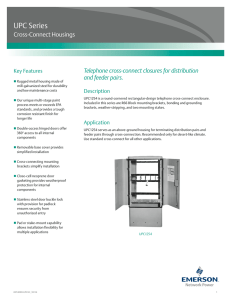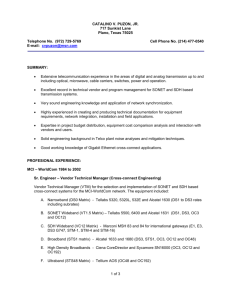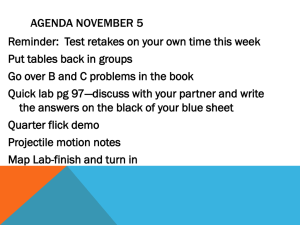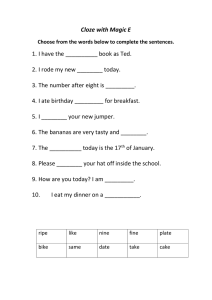DSX-1 Cross-Connect Procedures: Routing Guide
advertisement
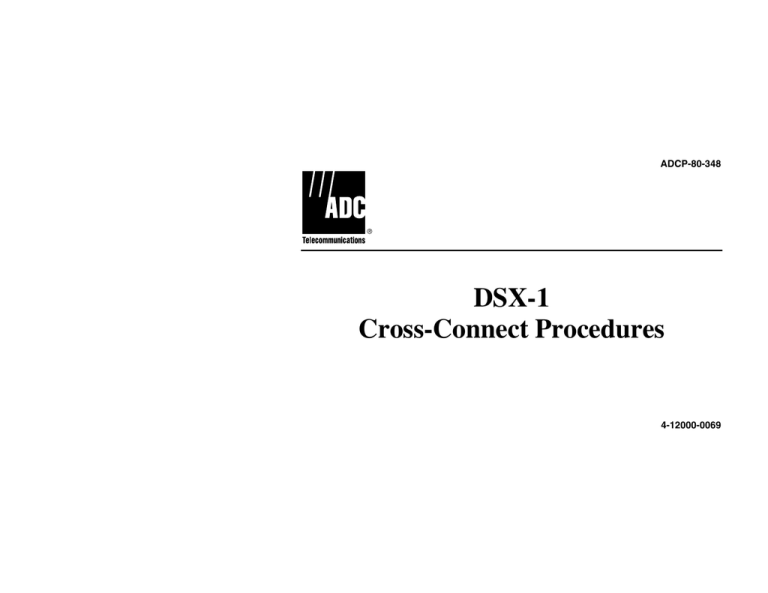
ADCP-80-348 DSX-1 Cross-Connect Procedures 4-12000-0069 ADCP-80-348 Issue 2, July 1997 DSX-1 CROSS-CONNECT PROCEDURES Content 1. Page CROSS-CONNECT ROUTING RULE PARAMETERS ............................................ 1 2. CROSS-CONNECT CABLE TYPE, LENGTH, AND LEVELS ....................................... 2 3. DSX BAY ZONING AND CROSS-CONNECT GUIDELINES ........................................ 3 4. CROSS-CONNECT JUMPER ROUTING RULES ................................................ 4 5. DSX-1 CROSS-CONNECT ROUTING PROCEDURE ............................................. 5 Disclaimer of Liability Contents herein are current as of the date of publication. ADC reserves the right to change the contents without prior notice. In no event shall ADC be liable for any damages resulting from loss of data, loss of use, or loss of profits and ADC further disclaims any and all liability for indirect, incidental, special, consequential or other similar damages. This disclaimer of liability applies to all products, publications and services during and after the warranty period. This publication may be verified at any time by contacting ADC’s Technical Assistance Center at 1-800-366-3891, extension 3475 (in U.S.A. or Canada) or 612-946-3475 (outside U.S.A. and Canada), or by writing to ADC Telecommunications, Inc., Attn: Technical Assistance Center, Mail Station #77, 4900 West 78th Street, Minneapolis, MN 55435, U.S.A. ADCP-80-348 Issue 2, July 1997 1. CROSS-CONNECT ROUTING RULE PARAMETERS A. General Routing Rules C. Cross-Connect Types 1.01 Several basic rules should be followed in routing cables to the DSX system: 1.03 The recommended types of cross-connect wire for each digital rate are: • Input and output digital signals should always be in separate cables. • DSX-1 and DSX-1C non-shielded, tinned 24 AWG, twisted pair wire. • DS1, DS1C, and DS2 cables should not be routed above bays or in a lineup associated with electromechanical or crossbar switching equipment. • DSX-2 Circuits Concentration Bay (CCB) type cross-connect cords for Bantam modules, and shielded pair 26 AWG wire with shield grounded at one end for Longframe (310) panels. • DS1, DS1C, and DS2 cables should not run parallel with power or ground cabling. B. Cross-Connect Lengths 1.02 The DSX cross-connect jumpers also add to digital signal-level losses depending on jumper length To assure reliable signal levels, maximum jumper lengths recommended for each DSX frame are: • DSX-1 and DSX-1C: 85 feet (25.9 m). • DSX-2: 15 feet (4.6 m). Page 1 © 1997, ADC Telecommunications, Inc. ADCP-80-348 Issue 2, July 1997 2. CROSS-CONNECT CABLE TYPE, LENGTH, AND LEVELS A. Cable Types C. Signal Levels 2.01 All DS1, DS1C, and DS2 cables should be shielded twisted pair with the shields grounded at one end only (preferably the equipment end). The recommended cable types are: 2.03 Each DSX frame serves as an equal level transmission point, and all digital signals crossing a DSX frame must be maintained within a certain voltage range for each specific bit rate. The peak-tobase voltage ranges for DSX frames are: • DS1, 655 feet (200 m): AT&T 600C or equivalent. • DS1, 450 feet (137 m): AT&T 1249 or equivalent. • DS1C, 655 feet (200 m): AT&T 600C or equivalent. • DS2, 1050 feet (320 m): AT&T 600C or equivalent. B. Cable Length and Gauge 2.02 The digital equipment terminated on the DSX frames have equalizers and/or pads which are adjusted for the particular cable lengths to maintain the proper transmission levels. The maximum cable length between digital equipment and DSX frames are governed by the specific items of equipment and cable gauges as follows: • DS1 and DS-1C, 22 AWG: 655 feet (200 m). • DS2, 22 AWG: 1050 feet (320 m). Page 2 © 1997, ADC Telecommunications, Inc. • DSX-1: ± 2.4 to 3.6 volts (± 3.0 volts, nominal). • DSX-1C: ± 2.3 to 4.2 volts (± 3.0 volts, nominal). • DSX-2: ± 0.55 to 1.3 volts (± 1.0 volt, nominal). ADCP-80-348 Issue 2, July 1997 3. DSX BAY ZONING AND CROSS-CONNECT GUIDELINES A. Cross-Connect Procedures 3.01 Figure 1 is a lineup of multiple DSX bays. Each bay is zoned in quadrants to provide the most efficient cross-connect scheme, maximizing the use of the vertical and horizontal wireways. When a cross-connect assignment is required, the following must be considered: • If the originating equipment is in zone one or two, the cross-connect jumper(s) must route to the adjacent bay via the upper wireway. • If the originating equipment is in zone three or four, the cross-connect jumper(s) must route to the adjacent bay via the lower wireway. BAY 1 BAY 3 HORIZONTAL JUMPER WIREWAYS ZONE ONE ZONE TWO ZONE THREE ZONE FOUR VERTICAL JUMPER WIREWAYS • Cross-connect jumper(s) must always be routed through vertical and horizontal wireways when crossing zones, except when cross-connecting within the same DSX panel. • When cross-connecting within the same bay from zone one (upper left) to zone three (lower left), the cross-connect jumper(s) must transition through the vertical wireway only. BAY 2 HORIZONTAL JUMPER WIREWAYS 5751-B Figure1. DSX Bay Cross-Connect Scheme Page 3 © 1997, ADC Telecommunications, Inc. ADCP-80-348 Issue 2, July 1997 4. CROSS-CONNECT JUMPER ROUTING RULES A. Cross-Connect Cabling 4.01 Cross-connect jumpers should be routed as shown in Figure 2. Whenever a cross-connect changes direction, it should do so at a point where a ring, tray or fanning strip is placed. This allows the cross connect to be dressed neatly without strain or interference with any other portion of the bays. 4.02 All cross connect jumpers should use the horizontal cable ways between bays, and vertical cable ways within bays. To prevent unnecessary jumper buildup and congestion, all discontinued cross connects should be removed from the DSX cable ways. Jumpers should be sized to the proper length, including a maximum of 3 inches of slack at each end. BAY 1 BAY 2 BAY 3 HORIZONTAL JUMPER WIREWAYS CROSSCONNECT JUMPER D E B A VERTICAL JUMPER WIREWAYS C C B HORIZONTAL JUMPER WIREWAYS A D F 1860-D ROUTING RULES A. All jumpers in the left-hand side of the cross-connect field should enter and leave the bay from the left vertical wireways. B. All jumpers in the right-hand side of the cross-connect field should enter and leave the bay from the right vertical wireways. C. All intrabay cross-connects should use the vertical rings except when terminations are in the same panel. D. All interbay cross-connects should use the horizontal wireways. E. All jumpers originating in the upper half of the cross-connect field should route via the upper horizontal wireways. F. All jumpers originating in the lower half of the cross-connect field should route via the lower horizontal wireways. Figure 2. Jumper Routing Rules Page 4 © 1997, ADC Telecommunications, Inc. ADCP-80-348 Issue 2, July 1997 5. DSX-1 CROSS-CONNECT ROUTING PROCEDURE 5.01 Follow the standard operating procedures for the routing of cross-connects based on local practice. For DSX-1 Bays and Modules, ADC recommends the use of five conductor jumper wire consisting of two independently twisted pairs (Signal Transmission) and a binding wire (used for Tracer Lamp identification). (Refer to Section 1 — Cross-Connect Routing Rule Parameters). terminals respectively. Terminate the green jumper wire to the TL (tracer lamp) wire wrap terminal. Inspect the wire wrap connections (see Figure 3). 5 CONDUCTOR JUMPER WIRE TWISTED PAIRS 5.02 Follow the steps as defined in your local practice or those indicated below to run a DSX-1 Cross-Connect Jumper. TL 1. Once the equipment assignments have been determined, strip the open end of the jumper wire as it comes off the spool. Caution: After properly stripping jumper wires, inspect area to ensure the removed insulation and wire clippings did not fall or land in the confines of the DSX bay line up. 2. At the originating end of the cross-connect, terminate the jumper wires to the IN and OUT – TN (tip normal) and RN (ring normal) wire wrap TN OUT RN TL TN IN RN CROSS-CONNECT TERMINAL BLOCKS TN RN OUT TN RN IN 1418-A Figure 3. DSX-1, DSX-1C Cross Connection (continued) Page 5 © 1997, ADC Telecommunications, Inc. ADCP-80-348 Issue 2, July 1997 CONNECT ROUTING PROCEDURE, continued 3. Carefully route the cross-connect jumper wire towards the terminating equipment ensuring that the zoning and routing procedures are followed as defined in Section 3 and 4. Figure 4 provides a pictorial view of the paths to be followed when routing via the upper and lower wireways. BAY 1 BAY 2 BAY 3 BAY 4 4. After the cross-connect has been properly routed, cut and strip the terminating end being careful to ensure the insulation and wire clippings do not fall into the DSX bays. 5. Repeat Step 2 for this end of cross-connect jumper. 6. Complete a final inspection of the cross-connect to ensure it is neat and properly placed within the wireways and the cable rings. 5752-C Figure 4. Do not pull jumper too tight — leave minimal slack and store evenly at each end (six inches total) Page 6 © 1997, ADC Telecommunications, Inc. ADC Telecommunications, Inc. 4900 West 78th Street, Minneapolis, Minnesota 55435 In U.S.A. and Canada: 1-800-366-3891 Outside U.S.A. and Canada: (612) 946-3000 Fax: (612) 946-3293

